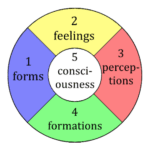the definitive Explanation of the 8-Fold Path
The 8-fold path of Buddhism refers to the Buddha’s teachings on proper conduct for life.
Concept: Eight-fold Path
Definition: A set of eight principles that guide individuals toward self-realization and enlightenment in Buddhism.
History and Origin:
- Originated in the teachings of Siddhartha Gautama, the Buddha, in the 6th century BCE.
- Taught as a central aspect of the Four Noble Truths.
Key Principles:
1. Right Understanding:
- Developing a clear and accurate understanding of reality.
- Recognizing the impermanence and suffering inherent in existence.
2. Right Thought:
- Cultivating wholesome and non-harming thoughts.
- Abandoning cravings, aversion, and delusions.
3. Right Speech:
- Speaking with integrity, truthfulness, and kindness.
- Avoiding gossip, slander, and harsh language.
4. Right Action:
- Engaging in ethical behavior that benefits others.
- Adhering to the five precepts: abstaining from killing, stealing, sexual misconduct, lying, and intoxicants.
5. Right Livelihood:
- Earning a living that aligns with ethical principles.
- Avoiding occupations that harm others or the environment.
6. Right Effort:
- Making diligent efforts to cultivate wholesome qualities.
- Overcoming obstacles and distractions.
7. Right Mindfulness:
- Paying attention to the present moment without judgment.
- Developing awareness of body, mind, and emotions.
8. Right Concentration:
- Training the mind to focus and remain present.
- Developing deep states of meditation and contemplation.
Significance and Relevance:
- Provides a comprehensive framework for personal growth and spiritual development.
- Helps individuals break free from the cycle of suffering and achieve lasting happiness.
- Used in a variety of Buddhist traditions, including Theravada, Mahayana, and Tibetan Buddhism.
Noble Eightfold path Table:
8-fold Path of Buddha
| PILLAR | SANSKRIT | MEANING |
|---|---|---|
| Noble Eightfold Path | ariya aṭṭhaṅgika magga | |
| HINAYANA | ||
| Right View | samyak-saṃkalpa | Stance of not-self, karmic cause and effect |
| Right Motivation, Resolve, Aspiration | samyak-saṃkalpa | Desire to liberate oneself from suffering, not engage in the kleshas |
| Right Speech | samyag-vāc | No lying, gossiping, slander, or harsh words |
| Right Conduct | samyak-karmānta | Not killing, stealing, sexual misconduct, or avarice |
| Right Livelihood | samyag-ājīva | Not selling arms, intoxicants, people, or sexual acts |
| Right Effort | samyag-vyāyāma | Limiting desires for pleasure. Simplicity of life, maintaining wholesome outlook of mind. |
| Right Mindfulness | Satipatthana | Unflagging focus on cutting karmic actions and seeing not-self |
| Right Meditation | samyak-samādhi | Shamatha, or stable concentration leading to vipassana, insight into not-self |
| MAHAYANA | ||
| Right View | samyak-saṃkalpa | View of emptiness |
| Right Motivation | samyak-saṃkalpa | Liberation of all beings from suffering, compassion |
| Right Speech | samyag-vāc | Helpful speech, guiding beings to the dharma |
| Right Conduct | samyak-karmānta | Exchanging oneself for others |
| Right Livelihood | samyag-ājīva | Actively helping, never harming. Seeing the illusory nature of life. |
| Right Effort | samyag-vyāyāma | Unceasing effort for the benefit of beings |
| Right Mindfulness | Satipatthana | Bare attention on emptiness |
| Right Meditation | samyak-samādhi | Equipoise seeing emptiness directly |
| VAJRAYANA | ||
| Right View | samyak-saṃkalpa | All beings are enlightened, Buddha fields are all-pervasive |
| Right Motivation | samyak-saṃkalpa | Seeing all beings as Buddha |
| Right Speech | samyag-vāc | All sound is mantra |
| Right Conduct | samyak-karmānta | Luminous light emanating and gathering |
| Right Livelihood | samyag-ājīva | 4 karmas of Buddha activity |
| Right Effort | samyag-vyāyāma | Maintaining samaya, non-effort |
| Right Mindfulness | Satipatthana | All phenomena are pure by nature |
| Right Meditation | samyak-samādhi | Deity, sugatagharba, mahamudra, trekcho, thogal |
Table of Contents
Little known fact: 8-fold path
The 8-fold path isn’t necessarily meant to be followed in a strict linear order (1, 2, 3, etc.). It’s more like an interconnected web or a wheel with each element supporting the others.
Here’s why:
- Mutually supportive practices: For example, practicing Right Mindfulness (awareness) can help you develop Right Effort (motivation and discipline) to maintain ethical conduct (Right Speech, Right Action).
- Gradual cultivation: Each element can be cultivated gradually over time. You don’t need to be a master of Right View (understanding) before working on Right Concentration (focused meditation).
- Dynamic and adaptable: The emphasis on different aspects of the path may shift depending on your individual needs and circumstances.
This understanding of the 8-fold path highlights the holistic and interconnected nature of Buddhist practice.
Understanding the Noble 8-fold Path

The teachings of Buddha have provided guidance and enlightenment to millions of people around the world. At the core of his teachings is the Eightfold Path, a set of principles that serve as a roadmap to achieving enlightenment and liberation from suffering.
This comprehensive guide will explore each aspect of the Eightfold Path, providing a deeper understanding of its significance and practical application in our lives.
8-fold path related terms
LSI Keywords for 8-fold Path
Concepts:
- Buddhism
- Noble Eightfold Path
- Path to Enlightenment
- Right Understanding
- Right Thought
- Right Speech
- Right Action
- Right Livelihood
- Right Effort
- Right Mindfulness
- Right Concentration
- Morality (Sila)
- Mental Discipline (Samadhi)
- Wisdom (Prajna)
Benefits:
- Reduced Suffering
- Increased Peace
- Improved Focus
- Greater Awareness
- Ethical Living
- Spiritual Growth
Related Ideas:
- Four Noble Truths
- Nirvana
- Karma
- Meditation
- Mindfulness
- Buddhist Ethics
Additional Terms:
- The Middle Way
- Wheel of Dharma
- Buddhist Practices
- The Eight Limbs
- The Noble Path
- Spiritual Development
- Self-Realization
- Liberation
8-Fold Path: Hinayana
The 8-Fold Path, also known as the Noble Eightfold Path, is a fundamental concept in Hinayana Buddhism, one of the two main branches of Buddhism. It is considered the path to achieving nirvana and escaping the cycle of suffering and rebirth. The path is categorized into three essential elements: wisdom (right understanding, right thought), ethical conduct (right speech, right action, right livelihood), and concentration (right effort, right mindfulness, right concentration). Followers of Hinayana Buddhism strictly adhere to this path as it guides them towards self-liberation, aligning with the school’s focus on individual salvation.
Key elements are the 4 Noble Truths, Selflessness, three marks of existence, avoiding causing harm, and restraint of desire.
8-Fold Path: Mahayana
The 8-Fold Path in Mahayana Buddhism is an essential guide to ethical conduct, spiritual discipline, and wisdom. This path, consisting of right view, right intention, right speech, right action, right livelihood, right effort, right mindfulness, and right concentration, serves as the blueprint for individuals to attain enlightenment and escape from the cycle of rebirth. Mahayana Buddhism has a more liberal interpretation of the 8-Fold Path, emphasizing the Bodhisattva ideal, where practitioners strive not only for their own enlightenment but also to help all sentient beings achieve liberation. This path is not a linear one but a set of interconnected practices that must be pursued simultaneously to realize the true nature of reality.
8-Fold Path: Vajrayana
The 8-Fold Path in Vajrayana Buddhism, also known as Tantric Buddhism, is a guide for personal spiritual development leading to the cessation of suffering and the achievement of self-awakening. The path is composed of eight practices that serve as a roadmap for cultivating wisdom, ethical conduct, and mental discipline. These are Right View, Right Intention, Right Speech, Right Action, Right Livelihood, Right Effort, Right Mindfulness, and Right Concentration. In Vajrayana, the 8-Fold Path is often practiced in conjunction with esoteric rituals and meditations, with a special emphasis on harnessing the energy of the body and mind to accelerate the journey towards enlightenment.
The First Step: Right View and Right Intention in the 8-fold Path
The Eightfold Path begins with Right View, which refers to the understanding of the Four Noble Truths – the truth of suffering, the truth of the cause of suffering, the truth of the end of suffering, and the truth of the path that leads to the end of suffering. Right View is the foundation upon which the entire path is built, as it provides the framework for understanding the nature of existence and the causes of our suffering.
Right Intention, the second aspect of the Eightfold Path, involves cultivating wholesome intentions and renouncing harmful ones. It is about developing a mindset of compassion, non-harming, and renunciation of greed, hatred, and delusion. Right Intention sets the stage for ethical conduct and mental development, which are explored in the subsequent aspects of the Eightfold Path.
Cultivating Ethical Conduct: Exploring Right Speech, Right Action, and Right Livelihood
Ethical conduct is a crucial aspect of the Eightfold Path, as it lays the foundation for a harmonious and compassionate society. Right Speech involves refraining from lying, divisive speech, harsh speech, and idle chatter. It encourages truthful, kind, and helpful communication that fosters understanding and connection.
Right Action extends ethical conduct beyond speech to encompass our actions. It involves refraining from killing, stealing, and sexual misconduct. Right Action encourages us to act with kindness, generosity, and integrity, promoting the well-being of ourselves and others.
Right Livelihood refers to engaging in a profession or occupation that is ethical and does not cause harm to others. It encourages us to choose a livelihood that aligns with our values and contributes positively to society. Right Livelihood promotes the idea that our work should be a means of supporting ourselves and others, rather than a source of exploitation or suffering.
The Path to Mental Development: Practicing Right Effort, Right Mindfulness, and Right Concentration
The final three aspects of the Eightfold Path focus on mental development, which is essential for cultivating wisdom and attaining enlightenment. Right Effort involves making a conscious effort to abandon unwholesome thoughts and behaviors, and to cultivate wholesome ones. It requires diligence, perseverance, and the willingness to let go of harmful habits and tendencies.
Right Mindfulness is the practice of being fully present and aware of our thoughts, feelings, and sensations in the present moment. It involves observing our experiences without judgment or attachment, cultivating a deep understanding of the impermanent and interconnected nature of reality.
Right Concentration refers to the development of focused and one-pointed attention through meditation. It involves training the mind to become calm, stable, and free from distractions. Right Concentration leads to deep states of concentration and insight, ultimately leading to the direct experience of enlightenment.
In conclusion, the Eightfold Path provides a comprehensive guide to achieving enlightenment and liberation from suffering. Each aspect of the path – Right View, Right Intention, Right Speech, Right Action, Right Livelihood, Right Effort, Right Mindfulness, and Right Concentration – plays a crucial role in our spiritual development. By understanding and practicing these principles, we can cultivate wisdom, compassion, and inner peace, ultimately leading to the realization of our true nature. As Buddha himself said, “The Eightfold Path is the path that leads to the cessation of suffering.”

May all beings be happy
May all beings be peaceful
May all beings be safe
May all beings awaken to the light of their true nature
May all beings be free








